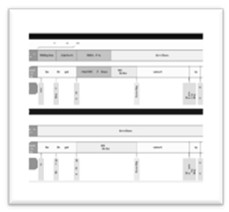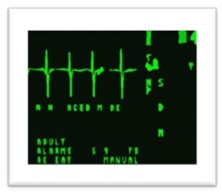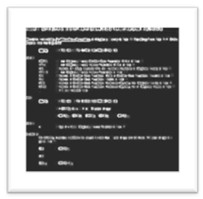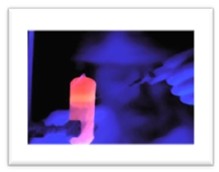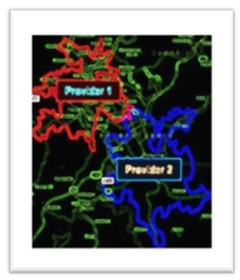| C A S E S T U D I E S >> S E L E C T E D |
|
C A S E S T U D Y 1
Do We Develop A New Service For Patients?
Challenge
Using an FMECA (Failure Mode, Effects and
Criticality Analysis, MIL-STD-1629A NOV.24.1980) exercise applied to a given
surgery process and patient treatment lifecycle, conducted with the complete
clinical team, yielded numerous problems and opportunities for performance
improvement.
Determination was made to develop a new,
potentially highly profitable service to make it easier to better serve
patients and aid in their treatment compliance. The problem was that the
undertaking was complex, needed cooperation from ~70 people internally to make
it happen, and went unaddressed for 12 months.
Exercise
Analysis - MediTechnix personnel performed
an initial business case which isolated and quantified the user populations,
interviewed pertinent service line heads to determine the application of this
new service for their patients, developed a competition SWOT analysis, and
conducted a pro-forma analysis which demonstrated very high gross margin
contribution. Working backwards from available meds available under the requisite
certification, through extensive interviews with service line directors and
CTCs, 12 Patient Populations were identified. The Business Case was approved by
Chief Operating Officer within 15 minutes of receipt.
Implementation - Isolated, directed, and
worked with Subject Matter Experts from both clinical and support services, and
senior administrators to develop (1) Required Certifications, (2) Project Plan,
(3) Standard Operating Procedures, (4) Computer Configurations, (5) Accounting
Treatments, (6) Delivery Mechanisms, (7) Risk Management and Stabilization
Strategies, (8) Personnel Responsibilities, Authorizations, and Performance
Measures, (9) Managed and ensured accurate submission for requisite $275 MM
surety bond, (10) others, which were required to make this undertaking a
reality, and make it sustainable.
Result
MediTechnix personnel’s’ SWOT (Strengths,
Weaknesses, Opportunities, Threats) and other strategic analyses demonstrated
that the new service could (was feasible) and should be undertaken to increase
(1) patient outcomes through better treatment compliance, (2) patient
satisfaction, (3) and enormous gross margin contributions to the hospital.
MediTechnix personnel designed complete
implementation strategy to make this new service a reality.
|
|

|
|
|
C A S E S T U D Y 2
Do We Forgo A Certain Service Line Because It Appears To Be Unprofitable?
Challenge
Determination
of whether to keep a high-profile service due to uncertainty whether it was a net positive economic contributor to the hospital. Per
conventional wisdom, it appeared to administrators as though it made 2
discrete gross margin contributions to the hospital.
Exercise
MediTechnix personnel performed a
necessarily detailed and complex economic assessment of the service and determined
there were actually 19 gross margin contribution events that occurred with the
delivery of this service. Thus making it one of the highest gross margin rates
contributors out of any service conducted within the hospital.
In order to aid adequate communication of
the actual economic effects, a simulation model was developed
which clearly showed the differential between the incomplete and complete
accounting cases.
Result
MediTechnix personnel’s analysis prevented
a gross multimillion dollar strategic mistake from occurring.
|
|
|
|
|
C A S E S T U D Y 3
What Is The Correct Staffing Model For An
Anesthesia Department; The “Best Mix” Of Providers To Maximize Patient Safety
And Satisfaction, And Facility Efficiency And Financial Return?
Challenge
Anesthesia departments are often a mix of
anesthesiologists, anesthesia residents, certified registered nurse
anesthetists and student nurse anesthetists. The ratio of these resources is
most times set arbitrarily rather than based upon financial models or other objective
methodology. Questions answered through the exercise included…
- Should specific service lines be staffed differently based on cost and
revenue?
- What is the correct mix and schedule of cases that will maximize patient
satisfaction, and the hospital’s financial return?
- For academic departments, how should residents be allocated to maximize
the department’s academic mission?
- What is the “ideal” number of trainees for a specific department?
- Should additional personnel be recruited?
- How should an anesthesia department negotiate support for additional
anesthesia sites or new service lines?
- What type and amount of financial support will be needed?
Exercise
MediTechnix personnel worked with the
anesthesia department to develop a full cost accounting model and pro-forma
model for the Department. This model included full costs for the Department’s
current labor resources, personnel allocation, service scheduling, financial
and growth projections. We also detailed the Department’s revenue obtained from
each service line that utilized anesthesia services. Next pro-forma models were
executed to show the financial impact of different staffing models for
different service lines. From these models, specific models of anesthesia
resources were developed with the resulting financial implications for each
service line. Models were also created to validate and monitor the cases
available for trainees.
Result
From this model the new service line was
able to increase resource utilization, patient satisfaction and throughput by
more than 30%. This led to significant increases to each Department’s finances.
The process was also implemented in a more efficient timetable than similar
prior projects.
MediTechnix personnel helped the Department chair obtain the
financial information needed to negotiate increased hospital support for the Department
to support additional anesthesia personnel. MediTechnix personnel’s analysis
assisted in a quick and profitable launch of a service line, which increased
patient safety, quality and economic return for both Departments and the
hospital.
|
|
|
|
|
C A S E S T U D Y 4
Are The Hospital
Treatment Protocols Aligned With The Latest Medical Knowledge, Do They Improve
Patient Care, And Do They Minimize The Cost To The Hospital System?
Challenge
The current
treatment protocols for Chest Pain and COPD are believed to be outdated
and require additional tests and treatments that are no longer indicated
in the latest medical literature. Current methods were believed to add needless nonvalue-added expenses to the
hospital, as well as dilating the treatment time for the patient.
Exercise
MediTechnix
personnel conducted extensive research into the latest, proven protocols
for both Chest Pain and COPD in order to determine the most effect
treatments, the most effective patient flow process and the one that
produced the best clinical outcomes. Working with hospital
clinicians, new protocols were outlined and tested. The new protocols
were vetted throughout the clinical leadership of the hospital and
adopted. All medical staff were then trained in the new protocols and
the results evaluated.
Result
The overall
results were the elimination of 3 unnecessary tests, the administration
of treatment moved to a more clinically appropriate time, and an overall
improvement in clinical outcomes. COPD patients received more
appropriate care. The Chest Pain patients were properly diagnosed
sooner in the evaluation process which enabled the patient to receive
more timely treatment.
|
|
|
|
|
C A S E S T U D Y 5
Do We Adopt A New Technology?
Challenge
Determination of whether to introduce a new
technology to replace a current technology.
Exercise
MediTechnix personnel isolated and
performed an assessment of 4 major utilizations of the technology, the
estimated likely annual demand in the service area for the first five years,
estimates of increased marginal gross margin contributions per year from the
new technology, and assessed any internal impediments that were likely to be
encountered during its introduction. We then conducted a “project financing”
pro forma investigation with risk factors noted for management purposes and
presented findings to executives.
Result
Relying upon MediTechnix personnel’s
analysis, the technology was adopted, is serving clinicians and patients well,
and has proven to be a net economic benefit to the hospital. The exercise also
increased prospective patient mindshare for the hospital when considering
sources of treatment.
|
|
|
|
|
C A S E S T U D Y 6
Should We Be Expanding,
Contracting, Or Keeping The Same Physical Plant And Clinical Capacity For A
Given Service?
Challenge
Determination of likely demand for a
surgical procedure over some time horizon, and required capacity to meet that
demand.
Exercise
MediTechnix personnel isolated the user
population attributes for a given service. We then normalized those data
relative to pertinent demographic parameters of the population in the service
area.
Using a proprietary population
growth simulation model developed by MediTechnix' parent company, which has
proven to have high accuracy for use in forecasting numbers of persons in a
locale (service area) in future years, we were able to predict the demand level
for the service over the time horizon of interest.
Result
MediTechnix personnel analysis determined,
all other factors being equal, that demand for that service would drop 30%+
over the next 5 to 7 years. Resultantly, it was advisable not to increase
physical plant capacity, and to take options on clinical service contracts,
rather than extending them for the foreseeable future.
|
|
|
|
|
C A S E S T U D Y 7
How Do We Manage The Supply
Of Critical Drugs That Are In Short Supply To Prevent Case Cancellations?
Challenge
Anesthesia Departments and Intensive Care
Units rely heavily on drugs like Diprovan for patient sedation and anesthesia
management. Recently, the drug Diprovan has experienced unanticipated shortages
on a nationwide level due to coming off patent protection.
These shortages, combined with
non-predictable supply delivery, led to the cancellation of elective
procedures and increased use of more expensive alternative drugs for others.
These cancellations and increased utilization of more expensive drugs resulted
in decreased patient satisfaction, lost revenue, and increased cost for the
hospital.
Exercise
MediTechnix personnel were asked by the
chairman of the department of anesthesia to develop models of supply management
to eliminate critical shortages of key drugs. Obtaining data from hospital
pharmacy, which included both delivery and utilization of key drugs, we were
able to model patterns of usage across Departments.
With this information we next looked at
supply order history, and vender completion rates. Using this data we were able
to build a reliable model of supply management to prevent critical shortages.
We also identified patterns of usage across Departments to allow for further
opportunities for better utilization management.
Result
MediTechnix personnel were able to work
with the Department of anesthesia to develop a new drug supply strategy to
eliminate shortages while minimizing costs. The model can also be expanded to
assist in the management of other critical resources.
|
|
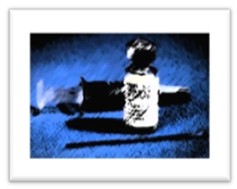
|
|
|
C A S E S T U D Y 8
Why Have We Seen A Decline In The Number Of
Patients In A Service, Yet Why Do We Always Seem To Have A Capacity Problem?
Challenge
Root Cause Analysis determination to
correct effects of compound problems, with planning considerations.
Exercise
MediTechnix
personnel isolated that the decline in the numbers of patients was due in large
part to patient dissatisfaction with their processing in-house. Development of
a Standard Operating Procedure (SOP) for correct and efficient handling of each
of 10 different types of patients was produced so that all clinicians, techs,
and administrators knew the procedure and their roles for each type of patient
introduced to the process.
A large contributor to incorrect and
inefficient patient processing was the discovery that all pertinent personnel
were working from 5 different static and real-time data sources, which were
generated and kept in different places, and were never in agreement.
Further, a utilization calculation was
performed to demonstrate that there was no problem with capacity, however the
utilization was inefficient due to several factors. A hybrid scheduling model
using static and stochastic elements to handle both scheduled and unscheduled
patients was developed for guidance into the future to better satisfy patient
processing.
Result
MediTechnix personnel analysis isolated the
major root causes of patient dissatisfaction, and resultant decline in the use
of the service.
MediTechnix personnel capacity and
utilization analysis demonstrated the need for better utilization of the
facility, rather than inefficiently adding millions of dollars of capacity.
|
|
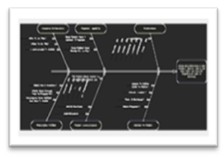 |
|
|
_____________________________________________________________________________________________________________________________________________________________
- Healthcare industry challenges can be complex and
multidisciplinary, and not easily placed into a particular category of
solution.
- Our
techniques are not off the shelf, or out of the literature. Our
techniques are proprietary and have been solely designed and developed
for our client set.
- Please contact us at gene.monaco@meditechnix.com or 412.657.7739
 412.657.7739 or use the "Contact Us" form to schedule a personal confidential meeting, or for more information, to determine how we may be of service. 412.657.7739 or use the "Contact Us" form to schedule a personal confidential meeting, or for more information, to determine how we may be of service.
- Allow us to prepare a custom solution proposal to address your challenges and opportunities.
_____________________________________________________________________________________________________________________________________________
© MediTechnix Incorporated 2012-2014. All rights reserved worldwide.
|

